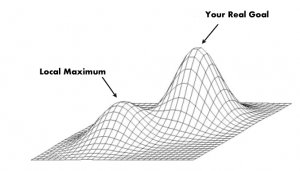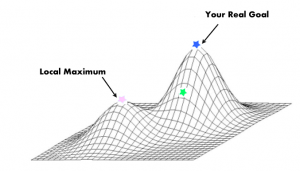 Imagine you’re climbing a mountain and the fog rolls in. You can’t see the trail as far as you’d like, but you know you’re trying to reach the top. So you figure as long as each step takes you higher than the one before, you’re headed in the right direction. So you slog on. Moving higher each time. Sooner or later you reach the top. You know this is the top because in each direction the next step takes you lower, ergo, it’s the top. So you make camp (hard to do in the fog) and settle in for the night.
Imagine you’re climbing a mountain and the fog rolls in. You can’t see the trail as far as you’d like, but you know you’re trying to reach the top. So you figure as long as each step takes you higher than the one before, you’re headed in the right direction. So you slog on. Moving higher each time. Sooner or later you reach the top. You know this is the top because in each direction the next step takes you lower, ergo, it’s the top. So you make camp (hard to do in the fog) and settle in for the night.
The next morning, the fog is gone, the sun shines bright and you see where you really are. You are indeed on top of the mountain, just not the mountain you wanted to be on. Off to the north is a higher mountain – the one you really wanted to reach. But between here and there is a valley. You have to go down to reach the higher peak.
How did you get here?
You focused on making every step count, but the fog kept you from seeing where you were truly headed. You never took a step down but ended up on the little peak.
This is called the “Local Maximization Trap” And entrepreneurs fall into it all the time without even knowing it. Why?
Because Entrepreneurs are good at what they do.
Entrepreneurs are smart, thrifty and opportunistic. That means we’re “scrappy.” We can make it where others can’t. And it leads us to take maximum advantage of our situation. That usually means making sure each step is a step up. We cut costs, work longer, drive harder, and surround ourselves with a team that does the same. We squeak out every bit of production from our equipment, our facilities, and our people. We have our eye on the bottom line and it works. Then one day, the fog lifts and we find we’ve reach a local maximum.
Rick’s Local Maximum
Let me give you an example of one of my clients. We’ll call him Rick. He runs a manufacturing operation, started by his Dad 50 years ago. He’s been at the helm for a number of years, but still calls on Dad for advice on a regular basis. They get along very well. The company actually grew in the past few years despite the recession. They did $5.8 million in business last year and are closing in on 6.5 million this year. 12% growth. Profit is climbing as well.
Rick wants to build his company to $10Million in sales and he thought he was on track. At 6.5 million he thought he was two thirds of the way up a $10 Million dollar mountain peak, with nothing but climbing ahead. That’s where the green star is in the picture. But he was wrong. He’s really on top of a localized peak – where the pink star is.
He’s actually such a good entrepreneur, that in fact he’s floating in the air above that peak. What I mean is he’s on top of a hill that’s maybe 6.3 million high and he’s milking almost 6.5 out of it. He’s that good. He can jump but he can’t fly. He’s going to have to go down to go up.
How do I know this?
I recently did an Orchestra Analysis of Rick’s company. What’s an Orchestra Analysis? It’s where we consider the company as an orchestra, with the CEO as conductor. We look at all the “instruments” in the company and see what notes they’re playing. There are a set number of instruments every company needs. What’s surprising to many people is that every company no matter how big or small needs all the same instruments. They just play louder or softer, or faster or slower in some companies than others.
To do an Orchestra Analysis we plot what notes all the instruments are really playing against the notes they should be playing to make the music the conductor wants, and see where the differences lie. Here’s some of what we found in Rick’s company.
When we looked at his sales operation we found most of the instruments were sitting idle. Rick doesn’t have any outgoing sales operation. He’s doing some advertising and giving quotes as the RFP’s come in. That’s how he’s growing. This is one reason he’s optimized his profit – his local maximum – because his sales costs are very low. But that has two serious ramifications. One is he’ll need to spend money building a real sales organization, one that reaches out, if he wants to grow. It also explains why even though the past few years have been good, profit in years before that has been erratic. He’s been at the whim of the market and not able to see changes coming in time to adapt.
There were other indications of a local maximum as well. His manufacturing space is maxed out. This also increases profit but limits growth.
Most critically, there is no in-house training program to develop line employees or
managers. This lowers his costs in the short term, but it keeps Rick trapped on the shop floor and not able to get out and move the company to the next level. That’s probably the biggest thing keeping him from growing the company the way he wants.
And the final indicator of a local maximum? Rick is turning down business, because he can’t fit it into the production schedule. This is a direct result of lack of investment in floor space, and developing employees.
At first he was turning down business he didn’t really want – C and D level customers. Loosing C and D customers is always a good thing. But he’s turning away some A’s as well. He estimates he turned away $200,000 in sales and $50,000 in profit so far this year. That’s a local maximum.
Local maximums aren’t all good
They can be – if you’re maximizing the right things and that’s where you want to be. But you can reach a maximum that feels like a pit if you’re maximizing the wrong things. You can maximize profit, for example, at the expense of cash flow; or market share at the expense of profit. That’s why before you do an Orchestra Analysis, figure out what song you want the orchestra to play.
In Rick’s case, he’s been closing in on this maximum for a while. Right now he’s maximizing profit, but that hasn’t always been the case. His frustration is that he’s maximizing his short term situation but sacrificing the sense of accomplishment and the money he sees in having a $10Million dollar organization.
Local maximums happen when you’re good at what you do and you move ahead one step at a time, without a good map of the territory. It’s not necessarily a bad thing if that’s the peak you want to be on. But in Rick’s case it’s not high enough. Here’s what I recommend if you’re in a similar situation.
Make a Map
Instead of moving ahead one step at a time, develop a map of where you are and where you want to be. Figure out how deep the valley is between the two. In Rick’s case that means figure out what kind of sales force he needs and what it will cost to develop one. Define what his training program should look like for managers and line employees. Understand how long will it take before he sees results from this. And decide what he should do about the lack of space, machinery and room in the schedule.
These things will all take investment. That’s what I mean by going down before you go up. He needs to have the resources, and the will, to cross that entire valley. If you don’t know how big it is, you can’t be sure you’ll make it to the other side. That’s why a good map is so important.
Takeaways:
- If you’re at a local maximum decide if you’re happy there or not. It might be fine.
- Don’t move forward till you have a map of how deep the valley really is and the resources to make it all the way across.
- If you’re not at a local maximum, with a good map you may be able to avoid one altogether.

